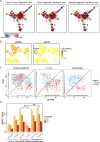Systematic evaluation of colorectal cancer organoid system by single-cell RNA-Seq analysis
- PMID: 35484598
- PMCID: PMC9047329
- DOI: 10.1186/s13059-022-02673-3
Systematic evaluation of colorectal cancer organoid system by single-cell RNA-Seq analysis
Abstract
Background: Patient-derived organoid culture is a powerful system for studying the molecular mechanisms of cancers, especially colorectal cancer (CRC), one of the most prevalent cancers worldwide. There are two main types of 3D culture methods for colonic cells, but the similarities and differences between gene expression patterns in different culture media remain largely unexplored.
Results: Here, we establish patient-derived organoids from colorectal cancer patients and perform single-cell RNA-Seq for pairwise samples from seven patients for both organoids and their corresponding tumor and normal tissues in vivo. We find that organoids derived from tumor tissues faithfully recapitulate the main gene expression signatures of cancer cells in vivo. On the other hand, organoids derived from normal tissues exhibited some tumor-like features at the whole transcriptome level but retained normal genomic features, such as CNVs, point mutations, and normal global DNA methylation levels, for both cultural media. More importantly, we show that conditioned medium outperforms chemical-defined medium in long-term culture of tumor epithelial cells. Finally, we mutually exchange the culture medium for the organoids and find that after interchanging the medium, the organoid cells basically maintain the transcriptome characteristics of the original medium.
Conclusions: Our work gives a thorough evaluation of both the cultural conditions and the biological features of organoids of CRC patients.
© 2022. The Author(s).
Conflict of interest statement
The authors declare that they have no competing interests.
Figures





References
-
- Fujii M, Shimokawa M, Date S, Takano A, Matano M, Nanki K, Ohta Y, Toshimitsu K, Nakazato Y, Kawasaki K, et al. A colorectal tumor organoid library demonstrates progressive loss of niche factor requirements during tumorigenesis. Cell Stem Cell. 2016;18:827–838. doi: 10.1016/j.stem.2016.04.003. - DOI - PubMed
Publication types
MeSH terms
LinkOut - more resources
Full Text Sources
Medical
Molecular Biology Databases

